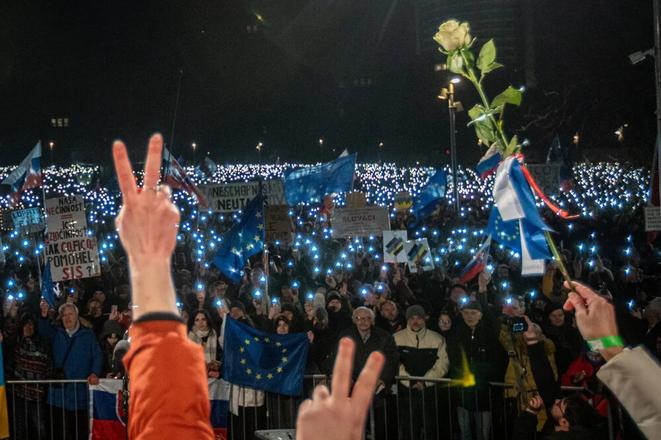Welcome to your weekly commentary and overview of news from Slovakia. Over 100,000 people came onto the streets to tell Fico that Slovakia is Europe and that he should leave. The government tried to ratchet up tensions before the protests – read on to see how the events unfolded. Hlas dismisses two of its MPs – but another two say they would abstain from voting with them, effectively stripping the ruling coalition of its parliamentary majority.
If you have a suggestion on how to make this overview better, let me know at michaela.terenzani@spectator.sk.
Huge nationwide protests give Fico a bad case of déjà vu
“Friends, Čadca has today finally joined the towns that care about the pro-European direction of our country,” Ľuboš Žárský, a local protest organiser, told the crowd that gathered in the town’s main square on Friday, January 24. Čadca lies in the north-west corner of Slovakia, near the borders with the Czech Republic and Poland.
The town is home to some 20,000 souls and has been a stronghold of Smer for years. In the 2023 election, about four in ten voters in the district voted for Smer and there has not been an anti-government protest there in seven years. On Friday, 400 people took to the square to join the countrywide protests organised mostly by local civil society organisations under the banner ‘Slovakia is Europe’.
They became part of a movement that motivated more than 100,000 people to protest on Friday, of whom 60,000 gathered for the protest in the capital, Bratislava, where organisers added a fifth demand to their existing list: they called on Robert Fico to resign as prime minister.
The final trigger for these latest protests came at the turn of the year, when Fico travelled to Moscow – a group of pro-Russian coalition MPs followed him there in mid January – and picked a fight with Ukraine’s President Volodymyr Zelensky over gas transit. This amplified concerns that have existed since before Fico returned as prime minister in the autumn of 2023 – that his government would play fast and loose with Slovakia’s democracy and risk its alliances with Western allies in the EU and NATO.
The massive protests, which came two weeks after an earlier round of public demonstrations, must have prompted an unpleasant sensation of déjà vu for Fico, who was forced out of office in 2018 following the murders of Ján Kuciak and Martina Kušnírová, when street protests demanded “a decent Slovakia”. In 2025, they are chanting that “Slovakia is Europe”, but, as in 2018, the prevailing slogan is “Enough of Fico”.
Fico, who has had continuing problems holding his own government together – something that became even clearer on the night after the protests – decided to give the people protesting against him déjà vu as well, by trying to trigger the primal instinct that has worked for him before and even helped him win elections in the past: fear. But, as in 2018, when he first started dropping the name of George Soros as a dog whistle and then spun a conspiracy theory about cobblestones supposedly hidden under bushes near the Government Office in preparation for an uprising, he has once again found that invoking fear does not work – at least not on free people.


 Slovakia is Europe protest in Bratislava, January 24, 2025. (source: Jozef Jakubčo, SME)
Slovakia is Europe protest in Bratislava, January 24, 2025. (source: Jozef Jakubčo, SME)